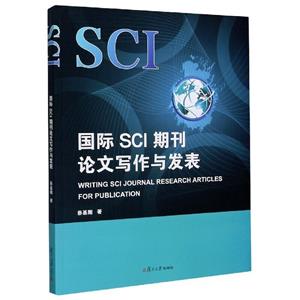掃一掃
關(guān)注中圖網(wǎng)
官方微博
本類五星書更多>
-
>
妙相梵容
-
>
基立爾蒙文:蒙文
-
>
我的石頭記
-
>
心靈元?dú)馍?/p>
-
>
女性生存戰(zhàn)爭(zhēng)
-
>
縣中的孩子 中國(guó)縣域教育生態(tài)
-
>
(精)人類的明天(八品)
中圖價(jià):¥27.5
加入購(gòu)物車
國(guó)際SCI期刊論文寫作與發(fā)表 版權(quán)信息
- ISBN:9787309151169
- 條形碼:9787309151169 ; 978-7-309-15116-9
- 裝幀:一般膠版紙
- 冊(cè)數(shù):暫無(wú)
- 重量:暫無(wú)
- 所屬分類:>>
國(guó)際SCI期刊論文寫作與發(fā)表 內(nèi)容簡(jiǎn)介
本書主要采用的理論框架是語(yǔ)類分析、語(yǔ)域分析、元話語(yǔ)和腳手架等,并按理工醫(yī)農(nóng)等科期刊論文的共性即IMRD安排內(nèi)容,分析語(yǔ)步語(yǔ)階,以及辨認(rèn)和分析與其對(duì)應(yīng)的句法、時(shí)態(tài)和元話語(yǔ)手段等語(yǔ)言特征。本書共10個(gè)單元,除*后一個(gè)單元是論文舉例,其他9個(gè)單元分別討論如何快速汲取科技論文的主要信息,如何撰寫引言部分和文獻(xiàn)回顧,如何收集數(shù)據(jù)和設(shè)計(jì)方法,如何通過(guò)文字和圖表有效呈現(xiàn)結(jié)果,如何通過(guò)解釋發(fā)現(xiàn)和對(duì)比類似研究來(lái)突出研究?jī)r(jià)值,如何撰寫論文摘要、標(biāo)題和參考文獻(xiàn),以及如何投稿、發(fā)表等。
國(guó)際SCI期刊論文寫作與發(fā)表 目錄
Unit One Preparing for Writing Research Articles
1.1 Being familiar with the characteristics of RAs
1.2 Deciding on a topic
1.3 Formulating aproblem/hypothesis
1.4 Using databases for references
1.5 Writing a proposal
1.6 Knowing the macro-structure of RAs
1.7 Reading titles for prediction
1.8 Reading abstracts for main ideas
1.9 Reading the key sentences in the Introduction and Discussion sections
1.10 Suggested readings
Unit Two Writing an Introduction Section
2.1 The moves of an Introduction section
2.2 Writing the initial sentences to claim centrality
2.3 Indicating the gap to be filled
2.4 Expressing the objective/purpose
2.5 Postulating a hypothesis
2.6 Introducing the methods and structure of the article
2.7 Tenses used in the Introduction
2.8 Signal words and cohesive devices
2.9 Fixed expressions for centrality, gaps and purposes
2.10 Re-use language in the Introduction
2.11 Suggested readings
Unit Three Writing a Literature Review
3.1 The elements of a Literature Review
3.2 The order of past studies
3.3 The content to review
3.4 Critical reading of the past studies
3.5 Synthesizing the sources
3.6 Citation function
3.7 Citation types
3.8 Citation methods
3.9 Verbs used to report past studies
3.10 Verb tenses in citation
3.11 Attitude markers
3.12 Re-use language in the Literature Review
3.13 Suggested readings
Unit Four Writing a Methods Section
4.1 The format of a Methods section
4.2 The elements of a Methods section
4.3 Study design
4.4 Describing the data and samples
4.5 Describing the materials
4.6 Describing the procedures
4.7 Research variables
4.8 Data analysis
4.9 Signal words for the purposes
4.10 Citations used in the Methods section
4.11 Active or passive verbs
4.12 Self-mention
4.13 Tenses in the Methods section
4.14 Suggested readings
Unit Five Writing a Results Section
5.1 The significance of the Results section
5.2 The choice of the data
5.3 The Contentof a Results section
5.4 The information elements Of the written part
5.5 The writing of the written part
5.6 The organization of results presentation
5.7 Data presentation
5.8 Designing and describing tables andfigures
5.9 Writing figUre legends and table titles
5.i0 Verb tenses and citations
5.! 1 FiXed expressions used in the Resuits section
5.12 Suggested readings
Unit Six Writing a Discussion Section
6.1 Writing a D~scussion section
6.2 The elements of a Discussion section
6.3 Highlighting the c0ntributi0n
6.4 Improving the chance' of being cited
6,5 Writing a C0nclusion
6.6 Hedging expressions
6.7 Attitude statements
6.8 Verb tenses
6.9 Fixed expressionS Used in the Discussion and Conclusion sections
6,10 Suggested readings
Unit Seven Writing an Abstract and a Title
7.1 Abstract
7.2 Verb tenses and self-mention in the Abstract
7.3 Fixed eXpression used in the Abstract
7.4 Keyords
7.5 Title
7,6 Supplemental information
7.7 Acknowledgments:
7,8 Author contributions
7.9 References
7.10 Suggested readings
Unit Eight Language and Style
8.i Style of scientific writing
8.2 The use of nominalizafion
8.3 Noun clusters
8.4 Impersonal structures
8.5 Subordinate structures
8.6 Modifier phrases
8.7 Lexical variation
8.8 Sentence variation
8.9 Using corpus analysis
8.10 Self-made CO~US
Unit Nine Preparing a Manuscript for Publication
9.1 Getting the paper published
9.2 Knowing the selection criteria of peer reviewers
9.3 Knowing the submission guidelines of a journal
9.4 Writing a cover;letter
9.5 Responding to the editors/peer reviewers
9.6 Writing a response letter
Unit Ten Reading Research Articles for Analysis
10.1 Effects of Communication About: Uncertaintv and Oncologist Gender on the
Physician-Patient RelationshiP
10.2 The Sound of Temperature: What Information Do Pouring Sounds Convey Concerning
the Temperature of a Beverage
10.3 DeepMood: Forecasting Depressed Mood Based on Self-Reported Histories Via
Recurrent NeUral Networks
10.4 Training End Users: An Experimental Investigation of the Roles of the Computer
Interface and Training MethodS
10.5 Changes in Diet and Lifestyle and Long-Term Weight Gain in Women and Men
10.6 Why Does Your Data Leak? Uncovering the Data Leakage in Cloud from Mobile Apps
10.7 Transfer Learning in Brain, Computer :InterfaCes
10.8 Patiromer Versus Placebo to Enable Spironolactone Usein Patients with Resistant
Hypertension and Chronic Kidney Disease (AMBER) A Phase 2, Rand0mised,
Double-Blind, Placebo-Controlled Trial
Appendixes
Appendix 1: Tables used in the book
Appendix 2: Course syllabus
Appendix 3: Course schedule
Appendix 4: ArtiCles :used as examples (AE)
References
Index
展開(kāi)全部
書友推薦
- >
李白與唐代文化
- >
【精裝繪本】畫給孩子的中國(guó)神話
- >
我與地壇
- >
羅曼·羅蘭讀書隨筆-精裝
- >
名家?guī)阕x魯迅:朝花夕拾
- >
月亮虎
- >
煙與鏡
- >
巴金-再思錄
本類暢銷
















